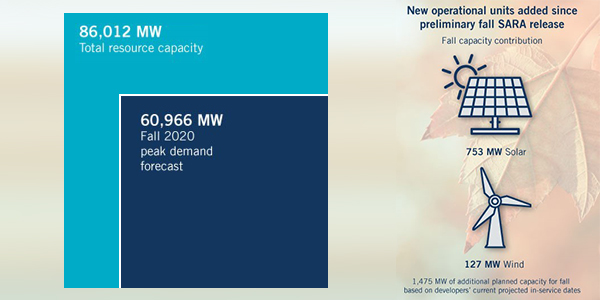ERCOT said Wednesday it expects “adequate” installed capacity available to meet demand this fall and winter.
The grid operator’s final seasonal assessment of resource adequacy (SARA) for the fall forecasts a peak demand of nearly 61 GW, unchanged from the preliminary fall forecast. It expects it will have more than 86 GW of capacity available. That takes into account a generation-outage projection of 14.3 GW, based on the historical average of outages for weekday peak hours during the last three fall seasons.
ERCOT has added 753 MW of solar capacity and 127 MW of wind capacity since the preliminary fall SARA. It also expects another 1.5 GW of planned wind and solar capacity to be online for the fall season (October and November).
“We study a range of normal to extreme scenarios prior to each season to determine whether there are any operational risks associated with meeting the forecasted peak demand,” Manager of Resource Adequacy Pete Warnken said in a press release. “At this time, our assessments show there will be adequate generation for fall and winter.”
ERCOT also released a preliminary SARA for the winter (December-February) that includes a peak-demand forecast of 57.7 GW, well below the winter demand record of 65.9 GW set in January 2018.
The assessment includes a low-wind scenario that will be used in all future seasonal assessments because of renewables’ growth in the ERCOT system. The grid operator reported a shade shy of 25 GW of installed wind capacity and 3.3 GW of installed solar capacity at the end of July, but its interconnection queue lists almost 77 GW of solar capacity and more than 25 GW of wind capacity in various forms of study.
Staff developed their peak-demand forecasts for fall and winter using revised Moody’s Analytics economic data obtained in April.





